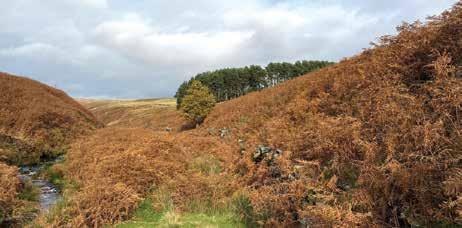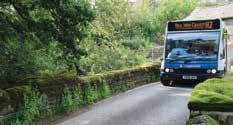
6 minute read
NEWS
Art installation celebrates National Park’s 70 years
Artists from Glassball, local schools, families, volunteers and National Park rangers are involved in a two-year arts and heritage project that is exploring the legacy of how the first National Park in the UK was formed.
GUIDEline focuses on the north west boundary area (from north of Glossop to Marsden), and what it means to visit, live and work along a mark made on a map 70 years ago.
Cora Glasser, lead artist at Glassball explains: “Our starting point was the original Park boundary document from 1951, which described the route in words alone.
“One element of our project celebrating the official birthday of the Park’s formation involves creating 3D printed and wooden laser cut words from the original description to display along the National Park boundary on a Covid-safe walk.
“Individuals and families can creatively arrange the words in suitable locations, photograph them and send the results in
Get inspired along the National Park boundary with the GUIDEline project.
to the GUIDEline website or post on social media.”
The GUIDEline website is growing as stories, recollections, LiDar scans, photographs, video and audio are being added. Join in and share your pictures on social media, use #GUIDEline.
For more information or to share your thoughts on how the boundary was created around Glossop, you can contact Cora Glasser by email: info@glassball.uk or visit www.guideline.org.uk
GUIDEline is funded by the National Lottery Heritage Fund and Arts Council England, and is supported by the Peak District National Park Authority.
Peregrines at 10 year high in the uplands
Goshawks and peregrines had a successful breeding season during 2020 in the Peak District’s uplands, according to a recent report. The Peak District Bird of Prey Initiative (BoPI) recorded 14 fledged young peregrines from six nests – the highest number for ten years – while an estimated 16-17 young PHOTO: TIM MELLING goshawks fledged from nine known nests. There were mixed fortunes for both short-eared owls and merlins, and hen harriers did not return to nest in the study area in 2020 after successful breeding in previous years.
Despite six incidents of illegal wildlife crime against birds of prey during the same period, efforts by the police and local gamekeepers have also recently secured the conviction of an egg-collector following a detailed investigation.

Helping a maiden in distress
National Park ecologists, local plant experts and landowners have joined forces to save a plant from extinction. Maiden pink is a very rare Peak District plant with less than a handful of remaining sites.
Rebekah Newman, ecologist, explains: “Maiden pink is a nationally nearthreatened species and after checking local records, we discovered that of the 17 populations recorded before 1990, there are now just four populations left.
“Most species which grow alongside maiden pink are taller and fastergrowing so the plant’s survival is critically dependent on grazing or some other disturbance to allow it to successfully compete and survive. We are developing site management plans for all the remaining populations to ensure maiden pink’s survival.”
Seed and cuttings have been taken from the wild populations and grown on in a local nursery. Maiden pink to get a helping hand to thrive in the Peak District.

Steve Furness of the Alpine Plant Centre in Calver says: “Our aim is to establish robust nursery populations so that we can bolster the existing populations with genetically identical but nursery grown plants. It’s like a zoo breeding programme for plants.”
To celebrate the 70th year of the Peak District National Park a number of sites are to be planted with 70 maiden pink plants to boost existing populations and establish new ones.

Revealing the past at Whitle.
Tudor farm group digs deep
The Tudor Farming Interpretation Group has received a National Lottery Heritage Fund grant and support from the Peak District National Park Communities Small Grant Scheme for a community archaeology project near Longnor.
Digging Deeper – The Origins of Whitle aims to reveal how people lived and farmed centuries ago at Under Whitle farm in Sheen. Plans to excavate a potential medieval house platform were put on hold in 2020 due to the pandemic, but the group hopes to dig later this summer.
Dr Ian Parker-Heath says: “Covid restrictions depending, we hope to offer people the chance to experience the thrill of uncovering the past and research how people lived. Volunteers will dig alongside professional archaeologists, learn new techniques such as archaeobotanical sampling, and be able to work towards the nationally recognised Archaeology Skills Passport.”
Archaeology trail guided walks are planned for later in the year with the trail open to the public in the future. Talks, reports and a website will share the group’s findings.
For more information contact: Dr Ian Parker-Heath diggingdeeper.
underwhitle@outlook.com
Hop aboard in the Hope Valley this summer
After being paused during the coronavirus pandemic in 2020, it’s hoped the popular Hope Valley Explorer seasonal bus service will be welcoming passengers again from late summer this year.
Subject to Covid-19 restrictions, the service is anticipated to run across weekends and bank holidays from late July to the end of October.
Larger capacity buses to support the potential need for social distancing and increased demand will mean the service will no longer be able to take in Edale, but will continue to visit Winnats Pass, Fairholmes and other local destinations across the valley.
Timetables will appear on our website and social media as soon as they are confirmed.

DANIEL WILDEY PHOTO:
Have you read ACID?
The archaeological excavation at the Roman fort of Navio, near Brough-on Noe, is featured on the front cover of this year’s Archaeology and ACID Archaeology and Conservation in Derbyshire and the Peak District ISSUE 18 JANUARY 2021 Navio’s long-lost vicus revealed Conservation in Derbyshire and the Peak District ACID magazine. Inside, reports Inside: from Tom
Peak District lead in
Parker and Vermeer’s earring
Swarkestone’s windmill
Reuben Thorpe Find of the Year (Archaeological Our year in numbers: planning and heritage statistics Research Services Ltd) show what has been unearthed at the first century monument. David Inglis, University of Sheffield, reveals new evidence about the wider landscape at Navio discovered by Castleton Historical Society volunteers and student archaeologists too.
Read about the unlikely links between the white paint on a world-famous historic Dutch painting, Alpine ice and Peak District lead workings in a report by Chris Loveluck, University of Nottingham.
The National Park Authority’s Anna Badcock reports on a project that is aiming to conserve and restore traditional stone field-barns in the Peak District National Park, and Natalie Ward writes about Scheduled Monuments.
Archaeology doesn’t get much more up-to-date and high-tech than in the article by archaeologist John Barnatt who dives deep into Ecton Mines with an international underwater exploration project, using submersible robots in the flooded workings of the old copper mines.
TV historian and archaeologist Neil Oliver also features in this edition of ACID in an interview by the magazine’s editor Roly Smith.
ACID showcases archaeological and conservation projects that have taken place in the Peak District National Park and Derbyshire over the last 18 months. It is produced jointly by the Peak District National Park Authority and Derbyshire County Council on behalf of the Derbyshire Archaeological Advisory Committee.
You can read ACID online at
www.peakdistrict.gov.uk/acid-magazine
and paper copies will be available at National Park Visitor Centres and Derbyshire libraries.










